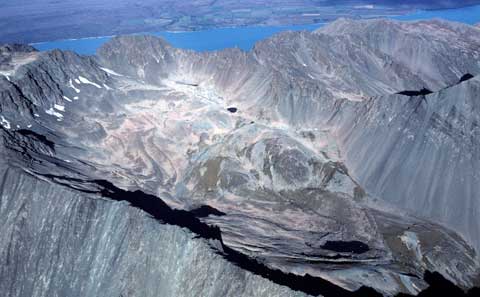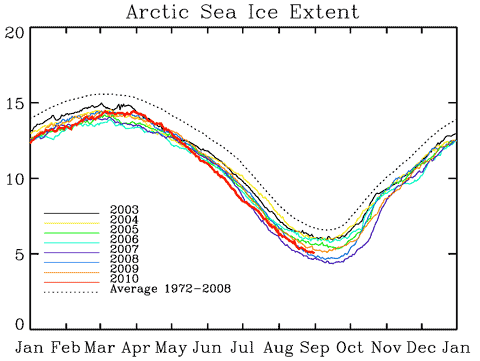Heidi Cullen takes readers forty years forward in her survey of what is likely to happen in several areas of the world if we continue to burn fossil fuels. Her book is The Weather of the Future: Heat Waves, Extreme Storms, and Other Scenes from a Climate-Changed Planet. It is a highly effective communication to the lay person of what climate science predicts for the specific areas she has chosen to explore. Cullen, a climatologist, works as a senior research scientist for Climate Central, an organisation set up in 2008 to act as a central authoritative source for climate change information.
Before moving to the selected areas for closer examination she offers some lucid general introductory chapters, including a very useful explanation of the use of modelling in climate prediction. In response to the question of when the weather will start to reflect predictions about the climate she answers that it already has in extreme weather events. If greenhouse gases continue to rise, the way weather affects life on Earth will be far worse than anything we’ve ever seen before. ”Can we rally around this forty-year forecast for the good of the world, or will we wait until the levees break before we decide to act?”
The first area Cullen surveys is the Sahel region of Africa. She talks with climatologists who work on understanding the rainfall patterns and outlook for the region. The picture is complex, but there is no doubt that the region is going to get warmer. All the models agree on that. They show some variation on the expected amount of rainfall, but it seems likely that the rainy season will start later and become shorter, with storms that will possibly become more intense. Pockets of resilience offer some hope from farmers who have turned to tree planting with considerable benefits to their crops and welcome extra income from the trees. But as Cullen takes her projections forward she remarks that there is only so much the trees can do against the increasing reality of climate change. Socially, climate change will become a threat multiplier as conflict spreads across the African continent in lockstep with temperature.
The next selected area is the Great Barrier Reef. Cullen talks with Joanie Kleypas, a marine ecologist and geologist who uses climate models to study the health of coral reefs. “I work on coral reefs, for God’s sake. The entire coral science community is depressed.” The chapter provides very clear accounts of the bleaching effect of warming oceans (“Bleached corals aren’t dead; they’re just starving.”) and the deleterious effect on coral growth from ocean acidification. The speed of both warming and acidification is likely to quickly outpace the conditions under which coral reefs have adapted and flourished through past changes. They are unlikely to be able to adapt fast enough. It’s not a good outlook. Cullen allows herself a detour to point to other and more dramatic effects of climate change that Australia is set to encounter – ferocious wildfires, pervasive drought, and unbreathable air. The lucky country looks anything but in coming decades.
The US is a leading per capita contributor to global emissions. It has not yet accepted the level of responsibility it carries. Other places, far less responsible and much poorer, are bearing the early consequences of global warming. But that doesn’t mean the US will remain exempt from any serious consequences, and it was good to see Cullen turning to her own country for two of her chapters, and driving home that message. One of the places she selects is Central Valley, California. The Sacramento-San Joaquin Delta is a focus of her attention here. It’s the hub of California’s water supply system. The Hollywood-style dream is that the Delta will be able to supply enough clean fresh water to help cities and crops increase “forever”, all without harm to the natural environment, she notes dryly. She speaks with a multidisciplinary team studying the Delta, which in reality has far more in common with New Orleans than with Hollywood. The details of the problems and threats are canvassed and the extreme vulnerability of California to coming water shortage exposed. Her other US focus is New York city. Here it will be energy blackouts which threaten as the average temperature increases over coming decades. The power grid is unsuited to climate extremes. The other major area not ready for what lies ahead is flood protection. However planning is going on in New York to develop resilience to what the changed climate will deliver, and also to mitigate the city’s emissions. Cullen imagines a time four years from now in which, following damage from a storm, a co-ordinated plan is finally adopted by an alarmed population and New York becomes a city obsessed with adapting to climate change. It clearly needs to.
Her other chapters look at more obviously and immediately vulnerable places. In the Arctic she examines the current experience of the Inuit in an area of Canada and in Greenland. Change is well under way as sea ice diminishes and permafrost melts. It brings with it not only the physical challenges to the Inuit ways but also severe cultural threats. In Greenland as the ice melts there’s the promise of wealth from resource extraction, and the ambiguities that come with it. Bangladesh is skilled in adaptation to change and experienced in flood management, but by 2050 with almost 25 per cent of the country under water as a result of rising seas and increasing tropical cyclones, accompanied by the slow and deadly seepage of saline water into wells and fields, Bangladesh will be in serious trouble. Millions of villagers will have to move to the city, and many are likely to cross illegally into India hoping to find work.
The value of Cullen’s book is that by focusing on specific places, and by talking with scientists who are devoting full attention to the problems climate change poses for those places, she brings the reader close up to inescapable realities. The details are spelt out. Moreover she does this by a lively narrative of her discussions with the scientists closely involved. Her book is not a dry account of scientific papers but a picture of the people working to understand, predict and prepare for what is in waiting for the populations in the areas she discusses. It’s a reminder too of the number and variety of people who now work on climate change-related issues.
The book recognises the adaptation capabilities being shown by some of the populations already affected by climate changes. It is with some reluctance that it acknowledges the possibility of defeat if high emission levels continue. They don’t need to continue, of course, but that is in the hands of policy makers. Cullen in conclusion examines two words in use in the science. One is unequivocal, used to describe the warming of the climate system. The other is irreversible, used to describe uncertain but all too possible eventualities. She uses the cutting down of the last tree on Easter Island, as imagined so vividly by Jared Diamond in his book Collapse, as an analogy for irreversibility. Unfortunately as yet the two words are not powerful enough in policy circles to shift the forecast for the future.
[More at: Fishpond (NZ), Amazon.com, Book Depository (UK, free shipping worldwide).]


 Auckland University
Auckland University  With the northern hemisphere summer fading into autumn, time for a quick overview of Arctic events. The sea ice is nearing its annual low point, and appears to be heading for a minimum somewhere between 2009 and 2008 — 2007’s record minimum appears to be beyond reach. The
With the northern hemisphere summer fading into autumn, time for a quick overview of Arctic events. The sea ice is nearing its annual low point, and appears to be heading for a minimum somewhere between 2009 and 2008 — 2007’s record minimum appears to be beyond reach. The 